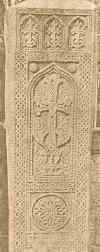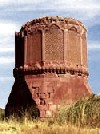 Julfa
is a border town on the southern part of the Nakhchivan exclave. It is
pleasantly located on the left bank of the river Araz, in front of
its sister town across the river: Jolfa in the Iranian province
of Central Azerbaijan.
Julfa
is a border town on the southern part of the Nakhchivan exclave. It is
pleasantly located on the left bank of the river Araz, in front of
its sister town across the river: Jolfa in the Iranian province
of Central Azerbaijan.
North of the town, on the south slopes
of the Daridaq range are located the famous Daridaq springs. Their water
contains iodine and cyanide, being used for medical purposes. Nearby arsenic
deposits are also found.
 Today's
town is but a shadow of its past. Julfa was an important cultural and
trade centre, located in an area that had both muslim and christian towns.
Julfa was part of the ancient caravan routes, then known by its Armenian
name - Jugha. However the wars between Turkey and Persia during the
15th, 16th and 17th centuries brought a lot of suffering to the region.
Julfa's region was given to Persia in 1555 by the treaty of Amasia, being
recaptured by the Turks in 1570-90.
Today's
town is but a shadow of its past. Julfa was an important cultural and
trade centre, located in an area that had both muslim and christian towns.
Julfa was part of the ancient caravan routes, then known by its Armenian
name - Jugha. However the wars between Turkey and Persia during the
15th, 16th and 17th centuries brought a lot of suffering to the region.
Julfa's region was given to Persia in 1555 by the treaty of Amasia, being
recaptured by the Turks in 1570-90.
Persia under Shah Abas I tried to
regain the area, conquering large extents of territory in 1603. Even through
these events, Julfa managed to survive. It had a population of over 20.000
souls. A Portuguese traveller, by the name
of Belchior, was in Julfa in 1604, reporting a large thriving town with
Christian population.
But 1604 was to be Julfa's meeting with
its fate. Shah Abas realized that he could no longer defend his conquests
against superior Turkish forces and ordered a retreat. Just weeks after
Belchior's visit, the Shah ordered not only a military retreat, but also
the en masse deportation of Julfa's citizens and the burning of the town.
The population was taken to Isphahan, were Julfa's artisans became famous
in the grand constructions promoted by Shah Abas. In Isphahan they created
a new settlement known as 'Nor Jugha', or 'New Julfa', which still subsists
today as a Christian enclave in Muslim Isphahan. The odyssey of these Julfans
is well depicted in the murals of Isphahan's Vank Cathedral
Julfa proper was left to be devastated
by invaders, plunderers, nature and time itself. For a long time it had
a small population made of muslim people who came from the neighbouring
villages. Large sections of old Julfa were destroyed in the first years
of the 20th century to build a railway line.
 Old
Julfa is locallly known as 'Cuga'. Today you can still imagine Julfa's
former grandeur, visiting what's left of the Andreordi, Pobloz and St.
Astvadsadsin churches, the main caravanserai, the 10th century fortress,
the remains of the bridge across the Aras, the 13th century Gulistan
'turbe' and the vast cemetery with thousands of artistically sculpted
tomb stones known as 'Khachkars'. Outside old Julfa, in a mountain gorge,
don't miss also the 13th century Amenaprkich monastery.
Old
Julfa is locallly known as 'Cuga'. Today you can still imagine Julfa's
former grandeur, visiting what's left of the Andreordi, Pobloz and St.
Astvadsadsin churches, the main caravanserai, the 10th century fortress,
the remains of the bridge across the Aras, the 13th century Gulistan
'turbe' and the vast cemetery with thousands of artistically sculpted
tomb stones known as 'Khachkars'. Outside old Julfa, in a mountain gorge,
don't miss also the 13th century Amenaprkich monastery.
Present day Julfa was founded only in 1848,
about 2 kilometres east from ruined old town. In modern Julfa there is
not much to see, the mosque is pleasant and the train station is rather
exuberant (there are rail services to Nakhchivan city). The very basic
Soviet hotel is near the station.
Today Julfa is again growing in importance,
as the main crossing point between Nakhichevan and Iran, both for rail
and road traffic (it is served by rail since 1906) .
 If
you wish to cross into Iran, expect long delays at the border, however
entering Iran is now a lot easier than a few years ago (see Iranian
visas). The Iranian government is quite eager for the Euros brought
in by the tourists, although they still prefer 'package tours' to independent
travellers. Anyway, if you are looking for a place to stay there is a nice
guest
house in Jolfa, which is a lot better than the hotel in Julfa. If you
cross the border do not miss the church of St. Stephan, before you head
further south.
If
you wish to cross into Iran, expect long delays at the border, however
entering Iran is now a lot easier than a few years ago (see Iranian
visas). The Iranian government is quite eager for the Euros brought
in by the tourists, although they still prefer 'package tours' to independent
travellers. Anyway, if you are looking for a place to stay there is a nice
guest
house in Jolfa, which is a lot better than the hotel in Julfa. If you
cross the border do not miss the church of St. Stephan, before you head
further south.
(450 km southwest of Baku)
| A to Z of Azerbaijan
/ A dan Z ye Azerbaycan |
www.azerb.com
|
 Today's
town is but a shadow of its past. Julfa was an important cultural and
trade centre, located in an area that had both muslim and christian towns.
Julfa was part of the ancient caravan routes, then known by its Armenian
name - Jugha. However the wars between Turkey and Persia during the
15th, 16th and 17th centuries brought a lot of suffering to the region.
Julfa's region was given to Persia in 1555 by the treaty of Amasia, being
recaptured by the Turks in 1570-90.
Today's
town is but a shadow of its past. Julfa was an important cultural and
trade centre, located in an area that had both muslim and christian towns.
Julfa was part of the ancient caravan routes, then known by its Armenian
name - Jugha. However the wars between Turkey and Persia during the
15th, 16th and 17th centuries brought a lot of suffering to the region.
Julfa's region was given to Persia in 1555 by the treaty of Amasia, being
recaptured by the Turks in 1570-90.
 Julfa
is a border town on the southern part of the Nakhchivan exclave. It is
pleasantly located on the left bank of the river Araz, in front of
its sister town across the river: Jolfa in the Iranian province
of Central Azerbaijan.
Julfa
is a border town on the southern part of the Nakhchivan exclave. It is
pleasantly located on the left bank of the river Araz, in front of
its sister town across the river: Jolfa in the Iranian province
of Central Azerbaijan.

